Substituting whole wheat flour in yeasted bread recipes
From white to wheat, a baker's guide
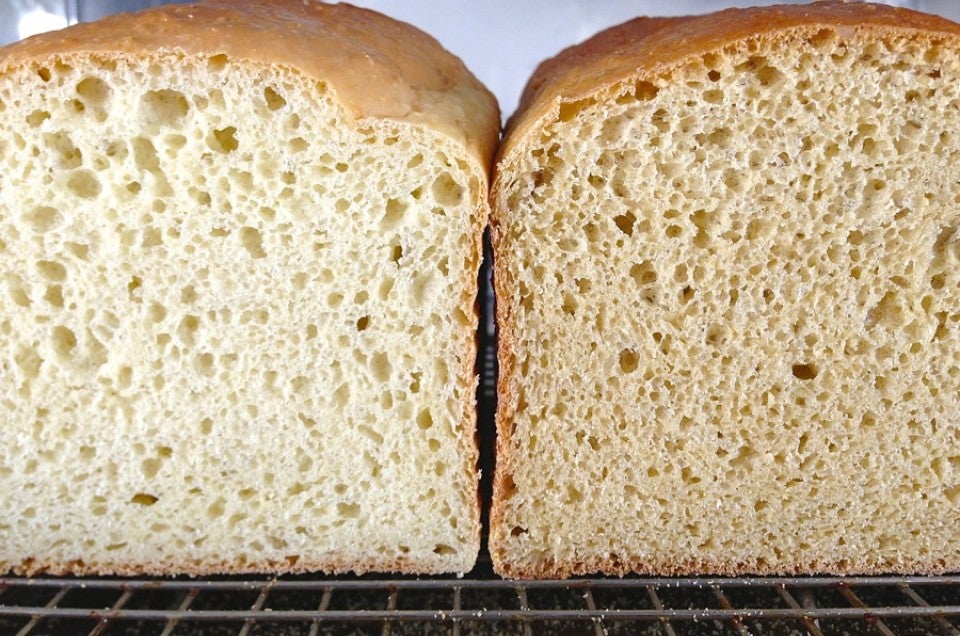

So, why do you want to bake with whole grains?
For some of us, it’s a desire to add fiber to our diet. For others, a lifestyle choice: avoiding heavily processed or refined foods – embracing “whole” foods.
Maybe you simply like the flavor of wheat. Or you’re trying to follow a healthier diet, which according to USDA dietary guidelines, means “Consume at least half of all grains as whole grains. Increase whole-grain intake by replacing refined grains with whole grains.”
Or perhaps you bought a bag of whole wheat flour because it was called for in a cookie recipe you wanted to try, and now you don’t know what to do with the rest of the bag…
Whatever the provenance of your desire to bake with whole grains – specifically, whole wheat – you’re probably not satisfied with simply following existing whole-grain recipes. You know, the ones in magazines like Real Simple, and Cooking Light.
It’s fine to try new whole-grain recipes every now and then; but what you’d really like to do is substitute whole wheat in some of your well-loved family favorites, making Anna’s Banana Bread or Gram’s Peanut Butter Blossoms or those Jordan Marsh Blueberry Muffins just a tad healthier.
Is it possible to do this – simply substitute whole wheat flour for the all-purpose (white) flour called for in your recipe-box recipes? Or is there some secret you don’t know – the need to increase liquid, decrease fat, wave your magic wand and spin around three times – in order to successfully convert a white flour recipe to whole wheat?
Thankfully, the process can be simpler than you think.

This post, the first in a guided series to substituting whole wheat for all-purpose (AP) flour, concentrates on the most challenging type of recipes to convert: yeast bread, rolls (including sweet rolls), and pizza.
But you know what? After lots of experimenting, I found a simple rule for substituting whole wheat with minimal change in the flavor, texture, and rise of your bread.

Here it is: in yeast recipes calling for all-purpose (white) flour, substitute King Arthur Golden Wheat Flour (formerly called "white whole wheat flour") for up to half the white flour, by volume. There’s no need to adjust any other ingredients. The result will be a loaf, roll, or pizza crust that rises nicely, has mildly “wheaty” flavor, and is a warm beige in color, rather than creamy white.
Bonus: you'll be treating yourself to a nourishing blend of the vitamins and minerals found in enriched all-purpose flour; and the fiber and additional vitamins and minerals in whole wheat flour. The two flours complement one another wonderfully well, not just in flavor and performance, but in dietary benefits.
If you like this 50/50 result, try substituting a bit more golden wheat next time. If you don’t – substitute a bit less. But half and half – AP and golden wheat flours – is a good place to start.
Now, what about substituting golden flour for 100% of the all-purpose – can you make a straight 1:1 switch?

Unless you’re willing to accept a loaf, roll, or crust that doesn’t rise as high, isn’t as light – then not a good idea.
BUT – there IS a way to use that straight 1:1 substitution, and turn white to 100% wheat, by making a few simple adjustments. More about that later.
OK, timeout. So, SO many of you have asked the following question, that I need to address it right now, before we go one step further:
Is our golden wheat flour (or as many of you knew it under its original name, "white whole wheat flour") really a whole-grain flour? Or is it a blend of white flour and whole wheat, or does it rely on some wacky type of processing to make it white, or…?
Golden wheat flour is 100% whole wheat – “nothing added, nothing taken away,” as we like to say here. It’s ground from white wheat berries rather than red wheat berries; but just as a red tulip and a white tulip are both tulips, red and golden wheat are both wheat.
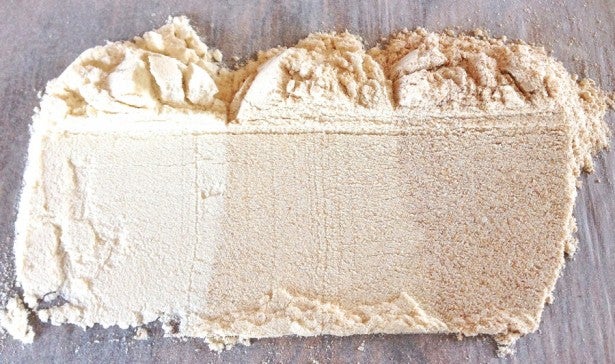
And when you grind the entire berry of either wheat – red, or white – the result is 100% whole wheat flour. Period. Take it to the bank.
If you love traditional red whole wheat (King Arthur Whole Wheat Flour, in the dark brown bag), more power to you; use it in good health. It’ll “work” exactly like white whole wheat in your recipe.
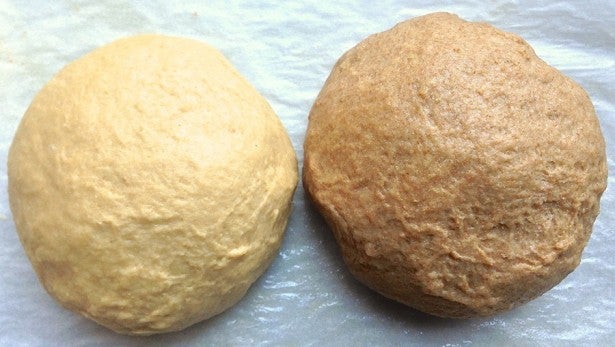
But if you’re someone who’s not in love with the assertiveness of whole wheat flour, take my advice: try golden wheat. Compared to red wheat, golden wheat’s mouth feel, flavor, and look are much closer to that of white flour.
Now, let’s explore some of the experiments that brought me to these conclusions. In all cases, I'm comparing the same recipe made using 100% all-purpose flour; 50% all-purpose and 50% golden wheat; and 100% golden wheat flour.
First up: a simple yeast batter bread, English Muffin Toasting Bread.

I'm using this recipe in order to see how golden wheat will act in a yeast bread that doesn't call for any kneading.
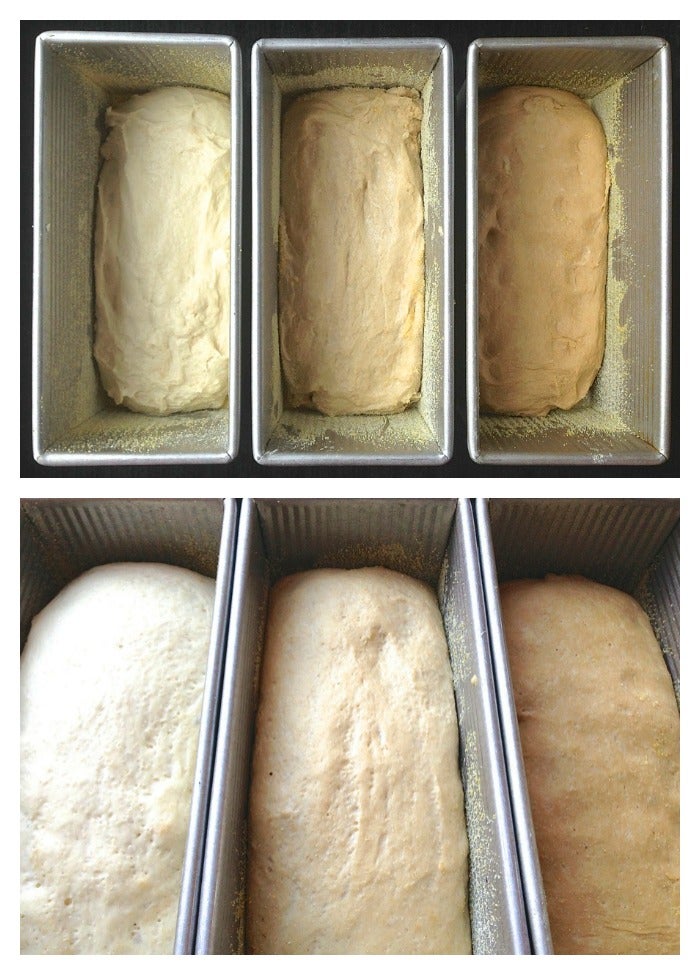
To make this simple bread, I combine all the ingredients in a bowl and, using an electric mixer, beat at high speed for 1 minute. The resulting sticky dough/batter is scooped into a loaf pan.* After a single rise, it's baked.
*I love using a 9" x 4" pain de mie pan for any bread recipe calling for an 8 1/2" x 4 1/2" loaf pan. The longer, narrower, deeper pan, with its straight (rather than slightly flared) shape, produces bread without the typical "mushroom" top – no getting stuck in the toaster!
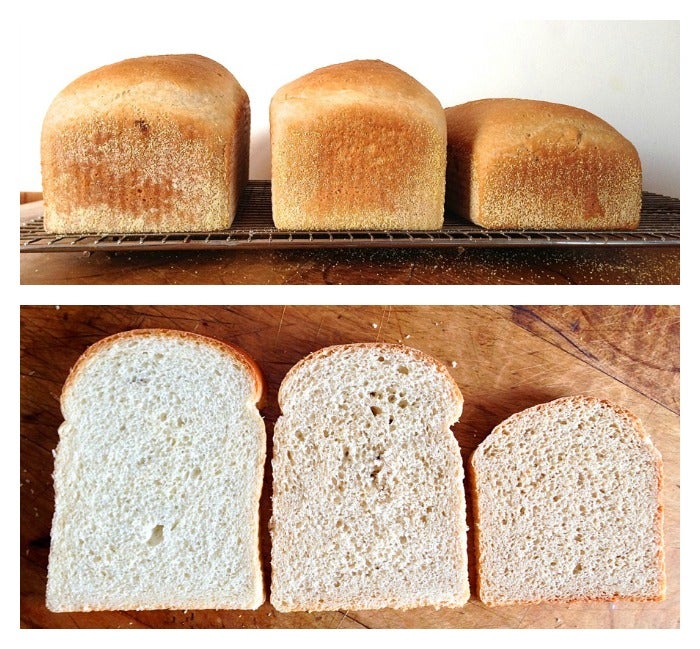
The result? The 100% white flour loaf rises just a tad higher than the 50/50 combo, while the 100% golden loaf is a distant third, rise-wise.
I'm a bit surprised at this result. Why would the 100% whole wheat loaf be SO far behind the 50/50 loaf?
Thankfully, as the experiments continue, I figure out the answer.
For my next loaf, I want an old family recipe, a tried-and-true white bread. I know many of you cherish your family recipes; let's see what happens when we substitute golden wheat flour in an older recipe, one clearly written for white flour.
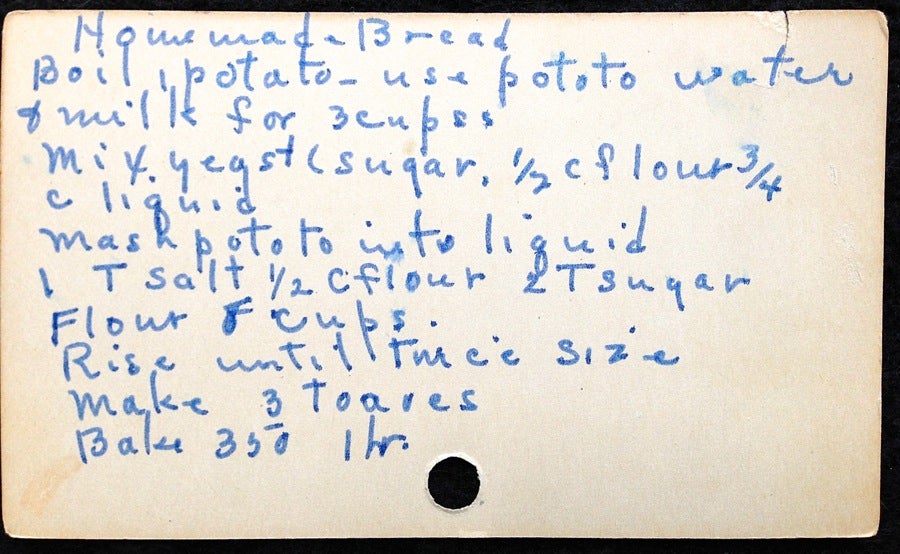
How many of you have recipes like this? Written in India ink on a yellowing card, stuffed in a worn cardboard box, this is my grandmother's recipe for the bread she made week after week, year after year, to feed her family – 7 kids and husband.
Clearly she didn't need a lot of direction!
But I did. It took me awhile to figure out, but eventually I used this skeleton to write myself a "real" recipe.
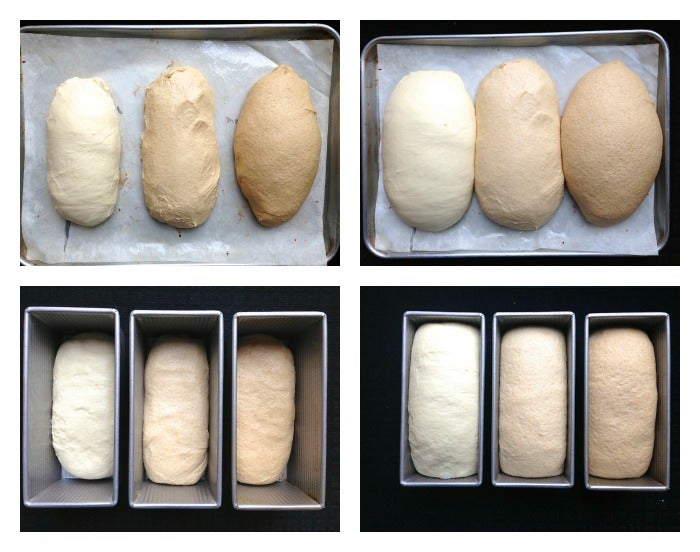
Remember: I'm using 100% AP (white) flour; a 50/50 blend; and 100% golden wheat flour. All three rise similarly through their first rise (on the baking sheet). And even the second rise doesn't produce huge differences...

...though you can see the AP loaf (left) is clearly taller than either the 50/50 or golden wheat loaves.
Once baked, though...
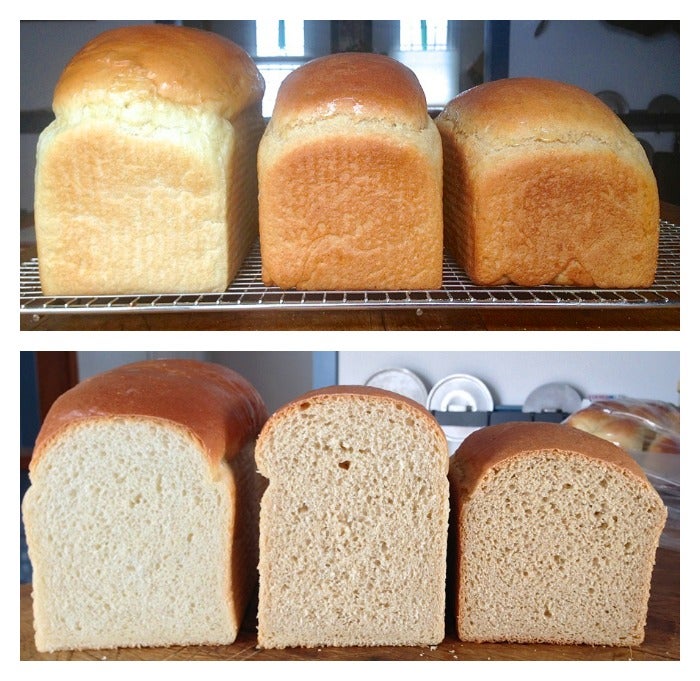
...the 100% AP loaf stands tallest – by a hair (crumb), over the 50/50 loaf.
The 100% whole wheat loaf wasn't too bad, though; a bit shorter, a bit denser, and it took longer to bake. Which is a good thing to remember: the denser/shorter the loaf, the longer it'll take to bake all the way through.
Next, let's sweeten things up a bit. How will a typical cinnamon roll or sticky bun turn out if I simply substitute golden wheat flour for all-purpose, without making any adjustments in the other ingredients?
Remember, this is all about simplicity; I want to figure out when you can successfully make a straight 1:1 switch with all-purpose and golden wheat; and when you can do so only by tweaking the recipe.
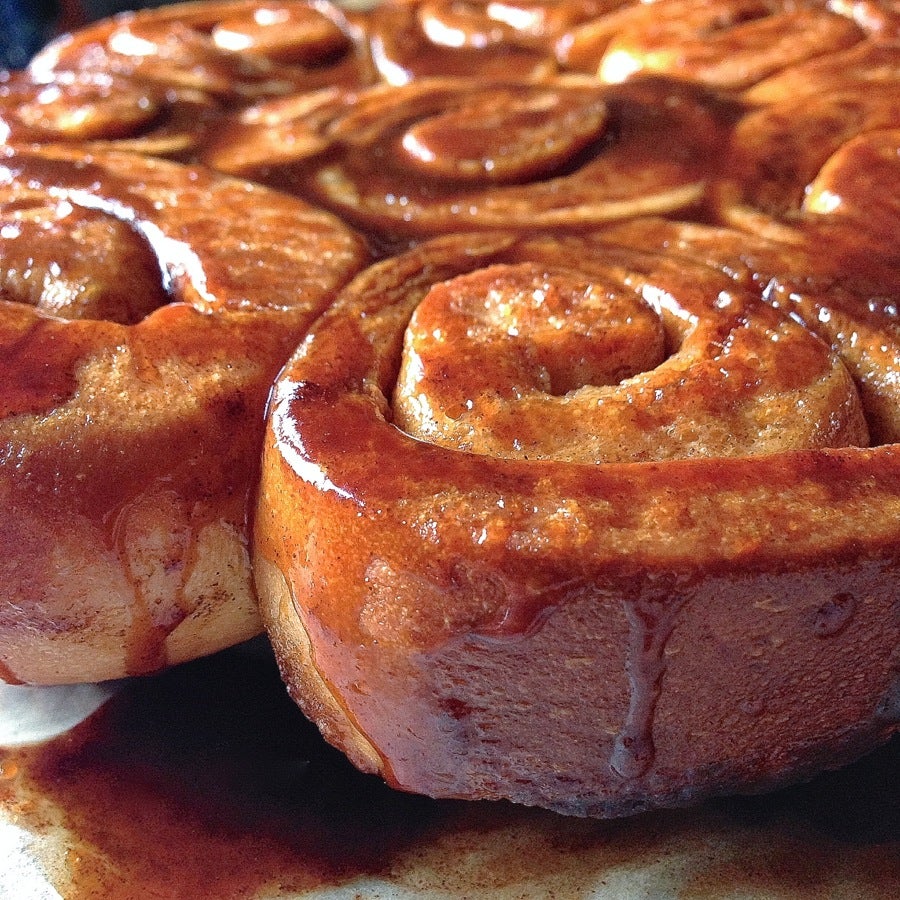
Our Cinna-Buns recipe is the quintessential breakfast sweet roll.
Let's see what happens using a straight 1:1 switch.
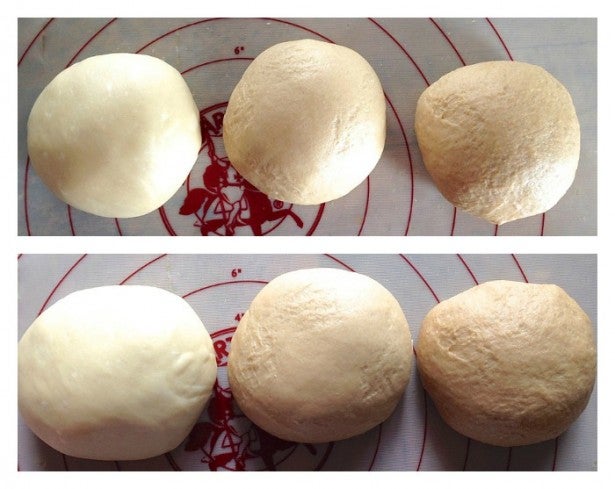
This rich dough, with its egg, milk, and sugar, is a fairly slow riser.
And the golden wheat dough seems stiff. It isn't rising quite as well as the AP and 50/50 doughs – which makes sense. Golden wheat, with its coarser grind and bran, takes longer to absorb liquid than AP flour. But once it does, it absorbs more. The same amount of water used in both an all-purpose flour and golden wheat flour bread recipe will yield golden wheat dough that's stiffer than AP dough.
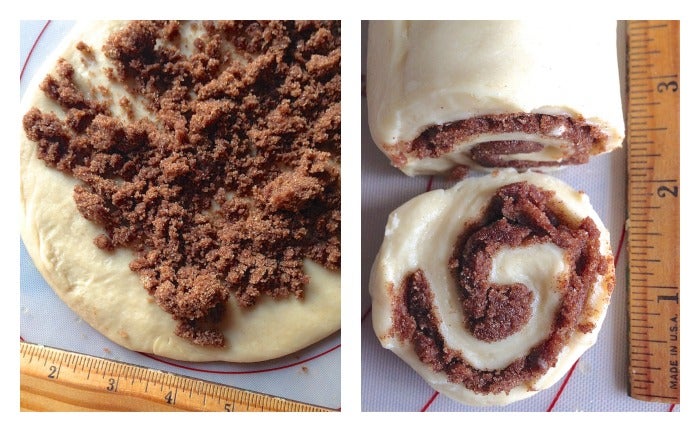
But let's continue with the rolls, and see what happens.

Uh-oh. While the AP (left) and 50/50 (bottom right) rolls are rising nicely, the 100% golden wheat rolls are lagging far behind.
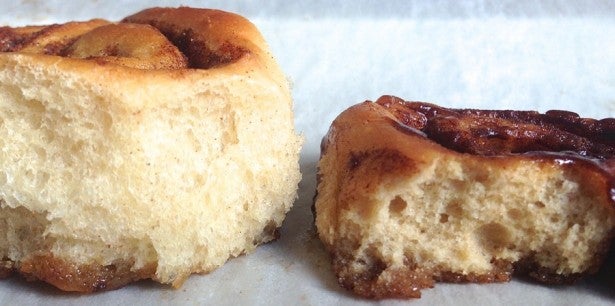
And the resulting 100% whole wheat buns – not up to snuff. Dense and stiff compared to the AP rolls, I need to throw these to the birds.
OK, I'm going to stop for a moment, and consider what I know about yeast dough.
Generally speaking, the stiffer and drier the yeast dough, the less it will rise. The CO2 produced by yeast has an easier time expanding the elastic network of gluten in which it's trapped when the dough contains more liquid.
Think of swimming upwards through water, vs. digging your way out of hard-packed dirt – get the picture?
What if I increase the amount of liquid in the 100% golden wheat dough, to give it the same soft, elastic consistency as the AP dough?
At the same time, I'll give the golden wheat dough 20 to 30 minutes to absorb the liquid before kneading; this should make the dough easier to work with, and prevent me from adding too much additional flour.
Let's try these Cinna-Buns again.
And this time, just to throw another variable into the mix, let's test traditional (red) whole wheat flour against golden wheat.
I make the dough again, adding 2 teaspoons additional milk for each cup of whole wheat flour in each of the 100% whole wheat recipes.
I also let the whole wheat doughs rest for 25 minutes before kneading.
I knead the doughs, let them rise, and shape them into buns.
And after 90 minutes rising in the pan...
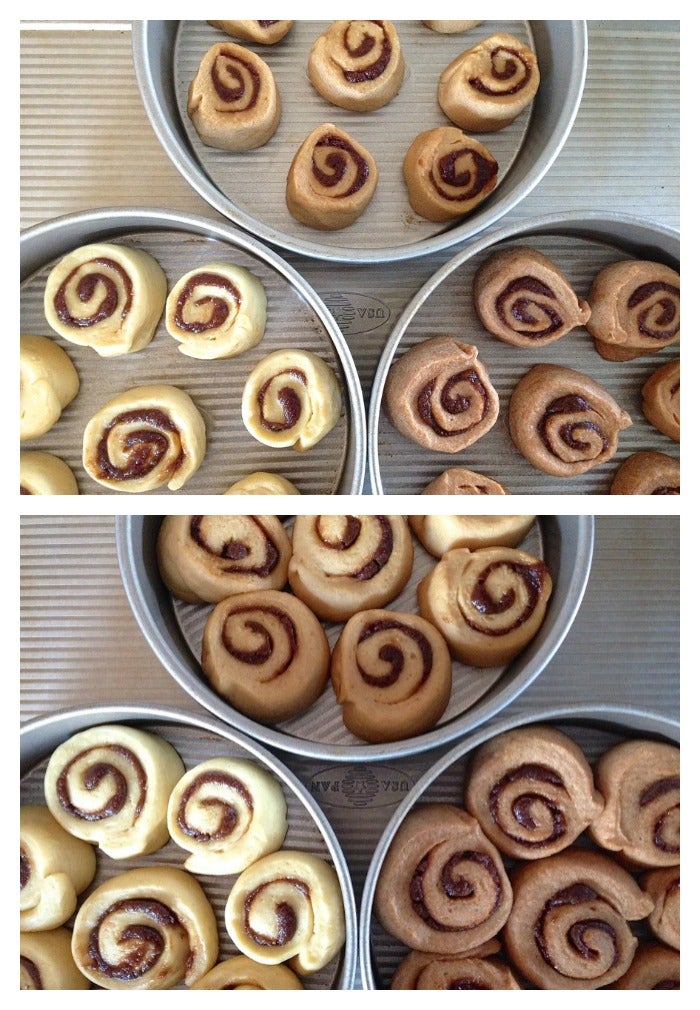
...success!
That's AP flour, bottom left; 100% golden wheat, center; and traditional (red) wheat, bottom right. All three are rising nicely.
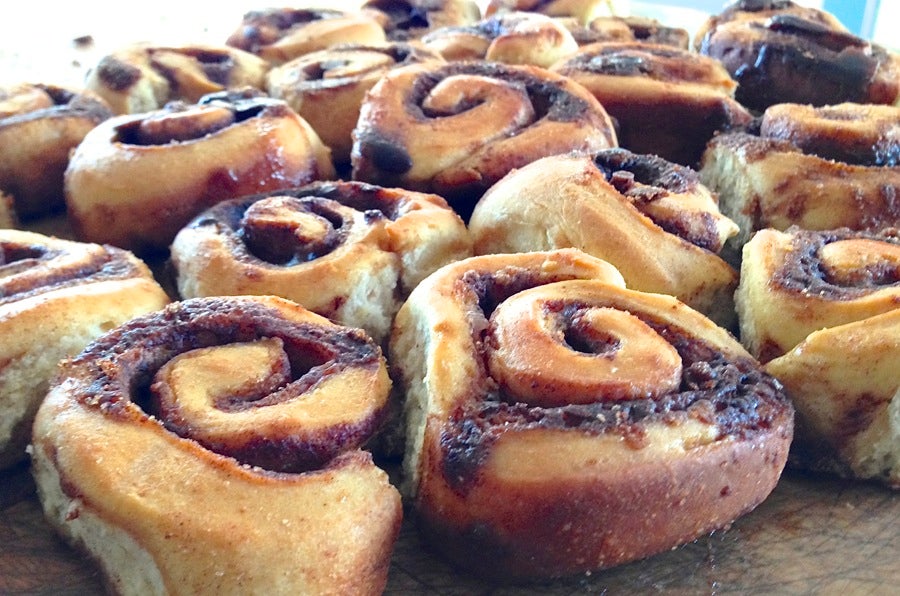
And after baking, you can't see a difference in height or texture.

Only the buns' color gives them away: that's traditional whole wheat in front; golden wheat in the center, and all-purpose flour in back.
OK, now that I know the secret to turning a white flour bread recipe into high-rising 100% whole wheat bread, let's test it on another old favorite: Amish Dinner Rolls.

This moist, dense potato roll recipe has been on our site for years, undergoing several changes along the way.
Substituting butter for lard, for instance – which gives you an idea of this recipe's vintage.
Using what I've learned about increasing the amount of liquid, and giving the dough a rest before kneading, will I make high-rising dinner rolls first time out of the gate?
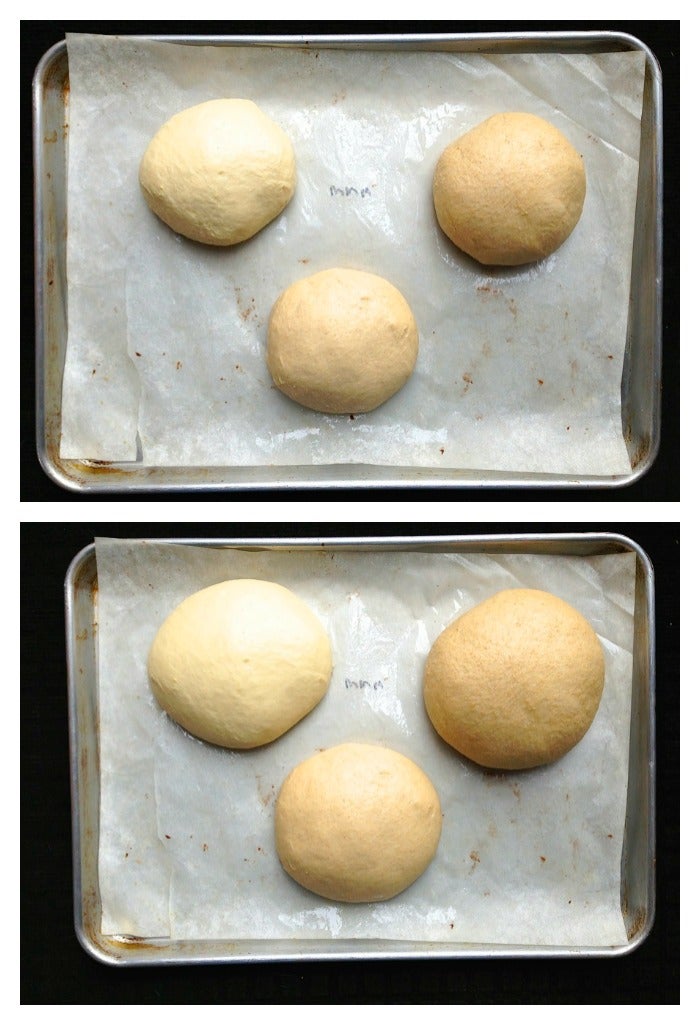
The dough looks good. It feels good, too; all three doughs (all-purpose, 50/50, and 100% golden wheat) are soft and supple.
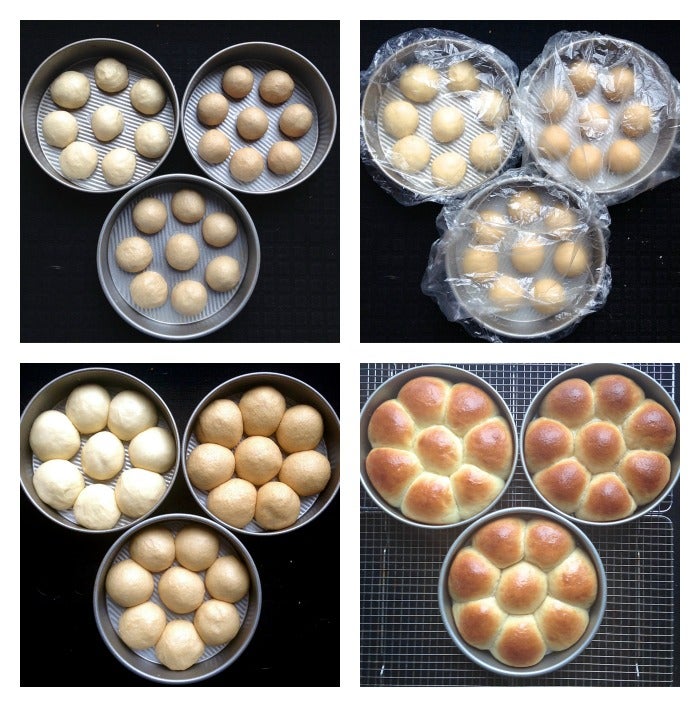
Shape rolls, nestle in pans. Apply elastic shower caps, for rising. (What, you don't know the Secret Life of Shower Caps - doubling as dough-rising covers?)
Nice rise... nice bake...

...nice buns!
While the late afternoon light paints a rather deceiving picture, kind of washing out the colors, that's 100% golden wheat, bottom left; all-purpose, top; and 50/50, bottom right.
All three rolls have risen nicely, and have great, light/soft texture.
And, finally – let's try some pizza dough.

Since I'm working on the second installment of my "America's Love Affair with Pizza" series concurrently with this post, I choose the basic pizza dough recipe from Wolfgang Puck's Pizza, Pasta, and More!
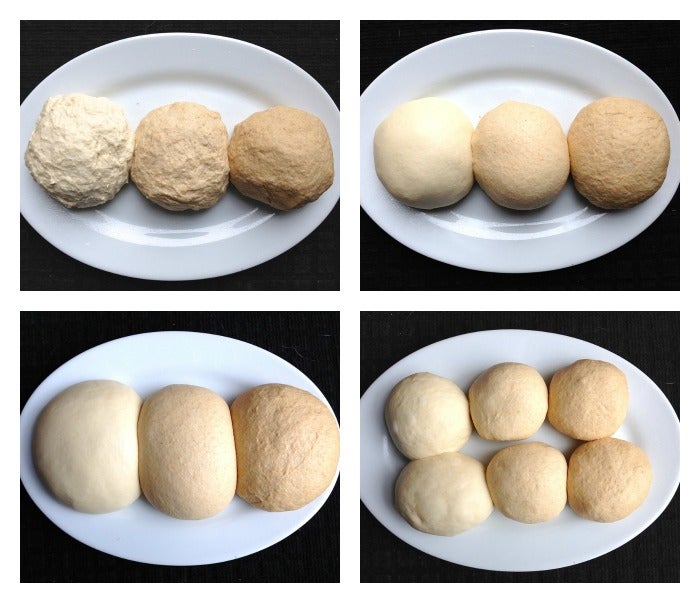
Again: all-purpose on the left, 50/50 in the center, 100% golden wheat on the right.
Notice how rough the dough is in the first shot (top left); all I've done at this point is mix the ingredients together, without kneading. Right after I take the shot, I knead the AP dough; then the 50/50; then, finally, the 100% golden wheat, which gives this last dough its requisite 25 minutes' rest.
They all rise nicely. I divide them in half, to make two 8" pizzas each.
Puck notes that the dough can be used right away; or refrigerated overnight before shaping and baking. So I try that experiment, too.
The result? I don't see a textural difference between using the dough immediately, or chilling it. There is, however, one difference in the all-purpose crust: the chilled dough is slightly more flavorful, due to lactic and organic acids produced overnight by the growing yeast.
I can't taste that same difference in the whole wheat doughs; I can only assume the flavor of wheat overrides the subtle flavors produced by the yeast.
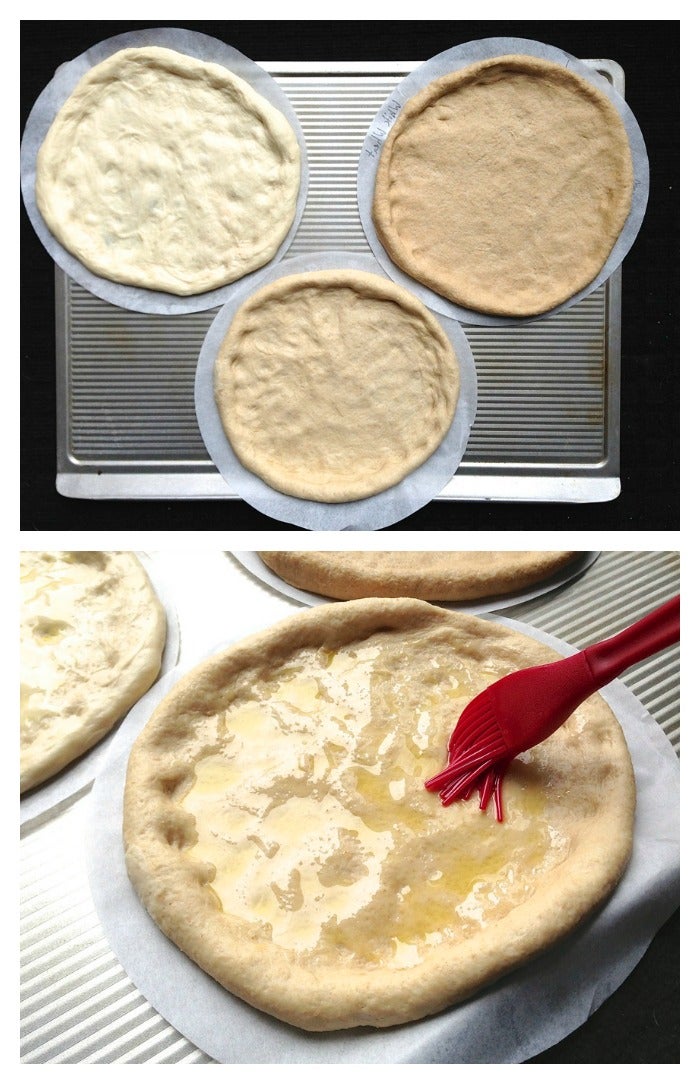
Here's the dough I'm using right away. I shape it, give it a short (30-minute) rise, and brush it with olive oil, per Puck's instructions...

...then bake.
Over-bake, actually. I mean to par-bake these, then add the toppings, then finish baking. But I misjudge how fast pizza crust can bake on a pizza stone in a 450°F oven.
Whoops.
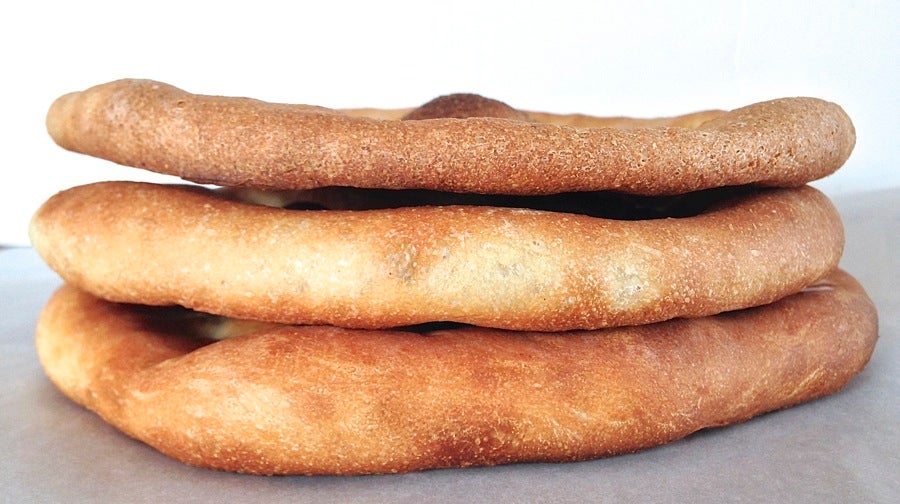
Anyway, here are the results: top to bottom, 100% golden wheat, 50/50, all-purpose.
Continuing to experiment with the amount of liquid necessary to make the highest-rising 100% whole wheat crust, I try adding slightly less additional water to the pizza crust than I do to the Amish roll dough. And there's a difference: the 100% golden wheat crust (top) isn't as light as the AP crust (bottom).
I do one final experiment, making the 100% golden wheat crust again, and upping the amount of water. And this time, the resulting crust is just as light as the AP crust.
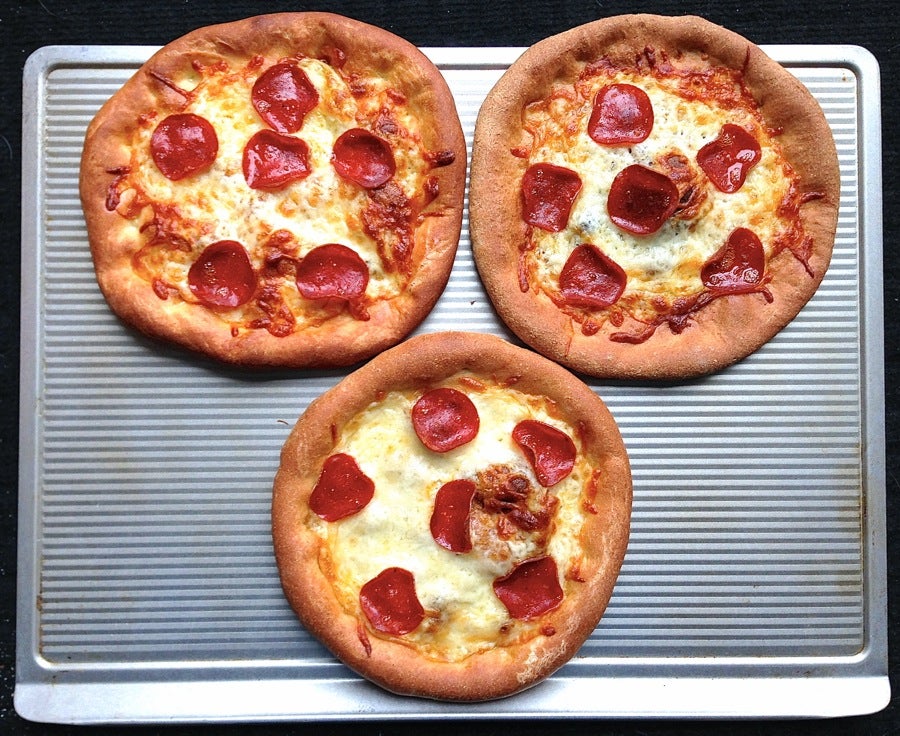
Now, back to those original over-baked crusts. Once I turn them all into finished pizzas, they're not bad.

One final shot: AP crust on the bottom, 50/50 on top. As you can see, the 50/50 crust is a warmer color, and rises just slightly less than the AP crust.
And there you have it: it's perfectly feasible to substitute whole wheat flour for all-purpose flour in your favorite yeast recipes. To summarize:
Oh, and another thing: when baking with whole wheat flour, I often substitute orange juice for part of the liquid called for in the recipe. Why? While it doesn't lend any flavor of its own, orange juice (used in small amounts) seems to temper the sometimes assertive flavor of whole wheat.
In addition, yeast loves an acidic environment, which orange juice helps create. A good rule of thumb is 1/4 cup OJ substituted for 1/4 cup of the water or milk in a recipe using 3 cups of whole wheat flour.
Finally, one last bit of advice: be sensible. Substituting whole wheat for 100% of the white flour in your favorite brioche, or challah, or croissant recipe, even if you add liquid, isn't going to create a light and tender, highest-rising, buttery, delicious brioche, or challah, or croissant. It'll be whole wheat – with all of whole wheat's inherent characteristics: darker color, stronger flavor, a less-smooth mouth feel.
When baking with whole wheat, it's best to understand the limits of any particular recipe, and manage your expectations. That said – I was never a particular fan of whole wheat, but after a week's worth of baking with it, I've gained new appreciation for its versatility, its ability to slip fairly seamlessly into white flour recipes – and even its flavor!
What's been your experience baking with whole wheat flour? Share your thoughts in comments, below.
Did you enjoy this baker's guide? Check out our guide to substituting whole wheat flour in your favorite cookie, brownie, and bar recipes.
Interested in purchasing King Arthur flours, including white whole wheat, at a store near you? Check out our store locator.